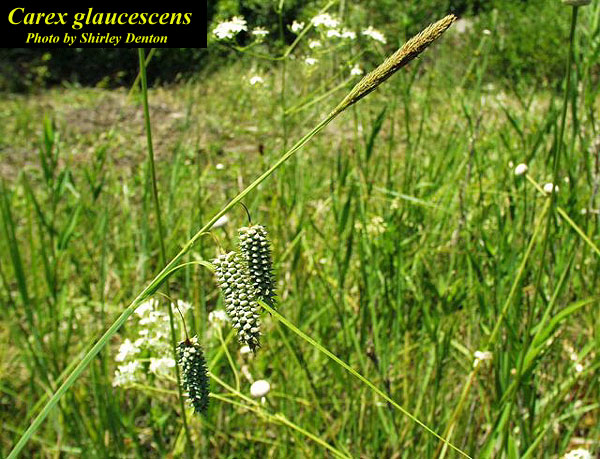Carex glaucescens
Common Names: Southern Waxy Sedge; Blue Sedge[1]
| Carex glaucescens | |
|---|---|

| |
| Photo by the Atlas of Florida Plants Database | |
| Scientific classification | |
| Kingdom: | Plantae |
| Division: | Magnoliophyta - Flowering plants |
| Class: | Liliopsida - Moncots |
| Order: | Cyperales |
| Family: | Cyperaceae |
| Genus: | Carex |
| Species: | C. glaucescens |
| Binomial name | |
| Carex glaucescens Elliot | |

| |
| Natural range of Carex glaucescens from USDA NRCS Plants Database. | |
Contents
Taxonomic Notes
Synonyms: none.[2]
Varieties: none.[2]
Description
C. glaucescens is a perennial graminoid in the Cyperaceae family that is native to North America. [1]
Distribution
C. glaucescens is found in the southeastern United States. [1]
Ecology
Habitat
C. glaucescens is considered an indicator species of common wetland habitats. [3] It can be found in pocosins, blackwater swamps, seepage bogs, wet pine savannas, pondcypress savannas, depression ponds, and other acid or peaty solutions.[4] Specimens of C. glaucescens have been collected from habitats such as wet pine flatwoods, wet sands of cypress pond swamps, burned over cypress gum swamps and wetland pine savannas, pine wetlands, wet roadside ditch, edge of creek on pine savanna, and marshy shore of lakes. [5]
Associated species: Taxodium ascendens, Nyssa biflora, Ludwigia sp., Lycopus sp., Eupatorium semiserratum, Eupatorium rotundifolium, Cyrilla racemiflora, and Juncus repens.[5]
Phenology
C. glaucescens has been observed to flower from March to October with peak inflorescence in July.[6] When it blooms, the perianth is absent.[7]
Fire ecology
Populations of Carex species have been known to persist through repeated annual burns[8]. This species has also been observed in cypress gum swamps and wetland pine savannas that are known to have been burned.[5]
Herbivory and toxicology
It consists of 5-10% of the diet of small mammals and terrestrial birds, and consists of 2-5% of the diet of large mammals. C. glaucescens is also an occasional source of cover for small mammals and terrestrial birds.[9]
Conservation, cultivation, and restoration
It is listed as endangered by the Maryland Department of Natural Resources.[1]
Cultural use
Photo Gallery
References and notes
- ↑ 1.0 1.1 1.2 1.3 USDA Plant Database
- ↑ 2.0 2.1 Weakley, A.S. 2015. Flora of the southern and mid-atlantic states. Working Draft of 21 May 2015. University of North Carolina at Chapel Hill, Chapel Hill, North Carolina.
- ↑ Carr, S. C., et al. (2010). "A Vegetation Classification of Fire-Dependent Pinelands of Florida." Castanea 75(2): 153-189.
- ↑ Weakley, A. S. (2015). Flora of the Southern and Mid-Atlantic States. Chapel Hill, NC, University of North Carolina Herbarium.
- ↑ 5.0 5.1 5.2 URL: http://herbarium.bio.fsu.edu. Last accessed: June 2018. Collectors: Cecil Slaughter, R. Kral, R.K. Godfrey, L.P. Gilespie, P.L. Redfearn, Robert L. Lazor, Steve L. Orzell. Edwin L. Bridges, R.R. Smith, Sidney McDaniel, Jean W. Wooten, A. F. Clewell, E.A. Hebb, Gil Nelson, A. Gholson Jr., Loran Anderson, R.A. Norris, Rodie White, Marc Minno, Albert B. Pittman, Kathy A. Boyle, Sudie Thomas, Herrick H. K. Brown, Richard Carter. States and counties: Florida: Flager, Madison, Jefferson, Liberty, Okaloosa, Santa Rosa, Gulf, Leon, Wakulla, Holmes, Washington, Calhoun, Franklin, Jackson, Walton, Gadsden, Escambia, Osceola, Baker, and Hamilton. Georgia: Clinch, Grady, Thomas, and Lowndes. South Carolina: Richland. North Carolina: Dare and Tyrrell.
- ↑ Nelson, G. PanFlora: Plant data for the eastern United States with emphasis on the Southeastern Coastal Plains, Florida, and the Florida Panhandle. www.gilnelson.com/PanFlora/ Accessed: 16 MAY 2018
- ↑ [[1]] Lady Bird Johnson Wildflower Center. Accessed: April 1, 2019
- ↑ Robertson, K.M. Unpublished data collected from Pebble Hill Fire Plots, Pebble Hill Plantation, Thomasville, Georgia.
- ↑ Miller, J.H., and K.V. Miller. 1999. Forest plants of the southeast and their wildlife uses. Southern Weed Science Society.